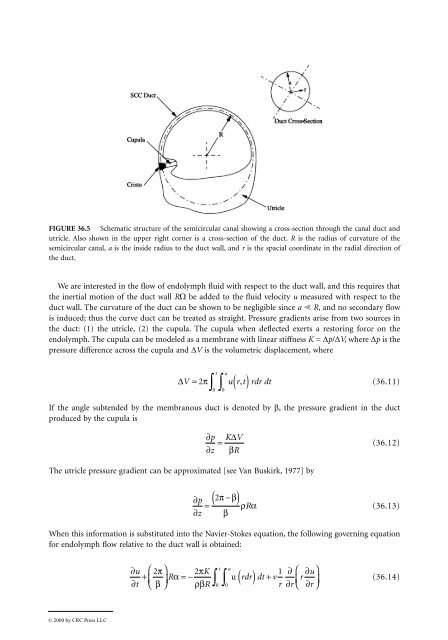chapter 36 - Vestibular Mechanics - KEMT FEI TUKE
chapter 36 - Vestibular Mechanics - KEMT FEI TUKE
chapter 36 - Vestibular Mechanics - KEMT FEI TUKE
You also want an ePaper? Increase the reach of your titles
YUMPU automatically turns print PDFs into web optimized ePapers that Google loves.
FIGURE <strong>36</strong>.5 Schematic structure of the semicircular canal showing a cross-section through the canal duct and<br />
utricle. Also shown in the upper right corner is a cross-section of the duct. R is the radius of curvature of the<br />
semicircular canal, a is the inside radius to the duct wall, and r is the spacial coordinate in the radial direction of<br />
the duct.<br />
We are interested in the flow of endolymph fluid with respect to the duct wall, and this requires that<br />
the inertial motion of the duct wall RΩ be added to the fluid velocity u measured with respect to the<br />
duct wall. The curvature of the duct can be shown to be negligible since a R, and no secondary flow<br />
is induced; thus the curve duct can be treated as straight. Pressure gradients arise from two sources in<br />
the duct: (1) the utricle, (2) the cupula. The cupula when deflected exerts a restoring force on the<br />
endolymph. The cupula can be modeled as a membrane with linear stiffness K = ∆p/∆V, where ∆p is the<br />
pressure difference across the cupula and ∆V is the volumetric displacement, where<br />
© 2000 by CRC Press LLC<br />
t a<br />
= π ( )<br />
0 0<br />
∆V 2 u r, t rdr dt<br />
(<strong>36</strong>.11)<br />
If the angle subtended by the membranous duct is denoted by β, the pressure gradient in the duct<br />
produced by the cupula is<br />
The utricle pressure gradient can be approximated [see Van Buskirk, 1977] by<br />
∫<br />
∫<br />
∂<br />
∂ =<br />
p K∆V z βR<br />
∂<br />
∂ =<br />
p ( 2π−β) ρRα z β<br />
(<strong>36</strong>.12)<br />
(<strong>36</strong>.13)<br />
When this information is substituted into the Navier-Stokes equation, the following governing equation<br />
for endolymph flow relative to the duct wall is obtained:<br />
( ) +<br />
∂<br />
∂ +<br />
⎛ π⎞<br />
⎜ ⎟ =−<br />
⎝ ⎠<br />
π<br />
u<br />
K<br />
∂ ⎛ ∂ ⎞<br />
R<br />
rdr dt v<br />
t ∫ ∫<br />
∂<br />
⎜r<br />
R<br />
r r⎝<br />
∂<br />
⎟<br />
⎠<br />
u<br />
t a<br />
2 2 1<br />
α<br />
u<br />
β ρβ 0 0<br />
r<br />
(<strong>36</strong>.14)








